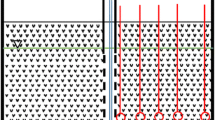Abstract
A laboratory experiment with two sequenced columns was performed as a preliminary study for the installation of a permeable reactive barrier (PRB) at a site where a mixed ground water contamination exists. The first column contained granular zero valent iron (ZVI), the second column was filled with granular activated carbon (GAC). Trichloromethane (TCM, 930 μg/l) and chlorobenzene (MCB, 260 μg/l) were added to the ground water from the site as the main contaminants. Smaller amounts (<60 μg/l) of benzene, 1,2-dichloroethane, 1,1,2-trichloroethane (1,1,2-TCA), 1,1-dichloroethene (1,1-DCE), trichloroethene (TCE), tetrachloroethene (PCE), 1,2-dichloropropane (1,2-DCP), bromodichloromethane (BDCM), dibromochloromethane (DBCM), tribromomethane (TBM), vinyl chloride and chromate were also added to the water to simulate the complex contamination pattern at the site of interest. PCE, TCE, 1,1-DCE, DBCM, BDCM, TBM, MCB and chromate were remediated in contact with ZVI, while the remaining contaminants showed incomplete degradation. A fraction of 8–16.5% TCM was converted to dichloromethane (DCM). Remaining contaminant concentrations were efficiently sorbed by the GAC until breakthrough of DCM was observed after 1,230 exchanged pore volumes in the GAC. The results show that the complex mixture of contaminants can be remediated by a sequenced PRB consisting of ZVI and GAC and that DCM sorption capacity is the critical parameter for the dimensions of the GAC reactor.








Similar content being viewed by others
References
Arnold WA, Roberts AL (2000) Pathways and kinetics of chlorinated ethylene and chlorinated acetylene reaction with Fe(0) particles. Environ Sci Technol 34(9):1794–1805
Blowes DW, Ptacek CJ, Benner SG, McRae CWT, Bennett TA, Puls RW (2000) Treatment of inorganic contaminants using permeable reactive barriers. J Contam Hydrol 45(1–2):123–137
Carey MA, Fretwell BA, Mosley NG, Smith JWN (2002) Guidance on the use of permeable reactive barriers for remediating contaminated groundwater. UK Environmental Agency NC/01/51, Bristol
Dahmke A, Schäfer D, Köber R (1999) Development of coupled in situ-reactors and optimisation of the geochemical processes downstream of different in situ-reactor systems. In: UFZ/TNO SAFIRA workshop, Bitterfeld, 17–18 November 1999, pp 73–77
Davis CC, Chen H-W, Edwards M (2002) Modeling silica sorption to iron hydroxide. Environ Sci Technol 36(4):582–587
Dries J, Geuens S, Bastiaens L, Springael D, Agathos SN, Diels L (2003) Multibarrier, a technology concept for the in-situ remediation of mixed groundwater pollution. Consoil 2003 (CD). In: 8th international FZK/TNO conference on contaminated soil, Ghent, 12–16 May 2003, pp 1650–1656
Farrell J, Kason M, Melitas N, Li T (2000) Investigation on the long-term performance of zero-valent iron for reductive dechlorination of trichloroethylene. Environ Sci Technol 34(3):514–521
Gavaskar A, Gupta N, Sass B, Janosy R, Hicks J (2000) Design guidance for application of permeable reactive barriers for groundwater remediation. Battelle Final Report, Columbus
Gillham RW, O´Hannesin SF (1994) Enhanced degradation of halogenated aliphatics by zero-valent iron. Ground Water 32(6):958–967
Guasp E, Wei R (2003) Dehalogenation of trihalomethanes in drinking water. J Chem Technol Biotechnol 78(6):654–658
Kaesche H (1990) Die Korrosion der Metalle—Physikalisch-chemische Prinzipien und aktuelle Probleme, 3rd edn. Springer, Berlin Heidelberg New York
Köber R, Ebert M, Schäfer D, Dahmke A (2001a) Kombination von Fe0 und Aktivkohle in Reaktionswänden zur Sanierung komplexer Mischkontaminationen im Grundwasser. Altlasten Spektrum 2:91–95
Köber R, Dethlefsen F, Plagentz V, Ebert M, Schäfer D, Dahmke A (2001b) Kombination von Fe0-Reaktionswänden und ORC zur Behandlung komplexer Mischkontaminationen im Grundwasser. TerraTech 3:54–59
Koenigsberg SS, Lapus KA, Sandefur CA (2000) A comprehensive evaluation on the use of oxygen release compound (ORC(®) in bioremediation. ConSoil 2000. In: 7th international FZK/TNO conference on contaminated soil, Leipzig, 18–22 November 2000, pp 1111–1112
Kouznetsova I, Bayer P, Birk S, Liedl R, Finkel M (2003) Numerical modelling for the sequenced use of zero valent iron and activated carbon for in situ groundwater remediation. Consoil 2003 (CD). In: 8th international FZK/TNO conference on contaminated soil, Ghent, 12–16 May 2003, pp 932–941
Matheson LJ, Tratnyek PG (1994) Reductive dehalogentaion of chlorinated methanes by iron metal. Environ Sci Technol 28(12):2045–2053
Morkin M, Devlin JF, Barker JF, Butler BJ (2000) In situ sequential treatment of a mixed contaminant plume. J Contam Hydrol 45(3–4):283–302
Parkhurst DL, Appelo CAJ (1999) User’s guide to PHREEQC (version 2)—a computer program for speciation, batch-reaction, one-dimensional transport, and inverse geochemical calculations. US Geological Survey Water-Resources Investigations Report 99-4259. Denver
Powell RM, Puls RW, Blowes DW, Vogan JL, Gillham RW, Powell PD, Schultz D, Landis R, Sivavec T (1998) Permeable reactive barrier technologies for contaminant remediation. US EPA Report EPA/600/R-98/125, Washington
Schäfer D, Köber R, Plagentz V, Dahmke A (2002) Entwicklung von gekoppelten in situ-Reaktoren und Optimierung der geochemischen Prozesse im Abstrom von verschiedenen in situ-Reaktorsystemen. Institut für Geowissenschaften der Universität Kiel, BMBF-Endbericht 02WT9938/0, Kiel
Schäfer D, Köber R, Dahmke A (2003) Competing TCE- and cis-DCE-degradation kinetics by zero-valent iron – experimental results and numerical simulation. J Contam Hydrol 65(3–4):183–202
Schlicker O, Ebert M, Fruth M, Weidner M, Wüst W, Dahmke A (2000) Degradation of TCE with iron: the role of competing chromate and nitrate reduction. Ground Water 38(3):403–409
Schwarzenbach RP, Gschwend PM, Imboden DM (1993) Environmental organic chemistry. Wiley, New York
Till BA, Weathers LJ, Alvarez PJ (1998) Fe(0)-supported autotrophic denitrification. Environ Sci Technol 32(5):634–639
Wiedemeier TH, Rifai HS, Newell CJ, Wilson JT (1999) Natural attenuation of fuels and chlorinated solvents in the subsurface. Wiley, New York
Wünsche L, Lorbeer H, Vogt C, Seifert K, Jorks S, Hard BC, Babel W (1999) Microbial colonization of the subsurface at the test site and degradation of chlorobenzenes by autochthonous bacteria of the quarternary aquifer. UFZ/TNO SAFIRA workshop, Bitterfeld, 17–18 November 1999, pp 73–77
Wüst W (2000) Verfahrenschemische Untersuchungen zur Sanierung CKW-kontaminierter Aquifere mit Fe(0)-Reaktionswänden. Dissertation, Institut für Wasserbau, Universität Stuttgart, 147 pp
Acknowledgements
Financial support for this study was provided by I.M.E.S. (Gesellschaft für innovative Mess-, Erkundungs- und Sanierungstechnologien mbH), Amtzell, Germany. Cr concentrations were determined by the ICP-MS laboratory of the Institute of Geosciences, University of Kiel.
Author information
Authors and Affiliations
Corresponding author
Rights and permissions
About this article
Cite this article
Plagentz, V., Ebert, M. & Dahmke, A. Remediation of ground water containing chlorinated and brominated hydrocarbons, benzene and chromate by sequential treatment using ZVI and GAC. Environ Geol 49, 684–695 (2006). https://doi.org/10.1007/s00254-005-0106-z
Received:
Accepted:
Published:
Issue Date:
DOI: https://doi.org/10.1007/s00254-005-0106-z




